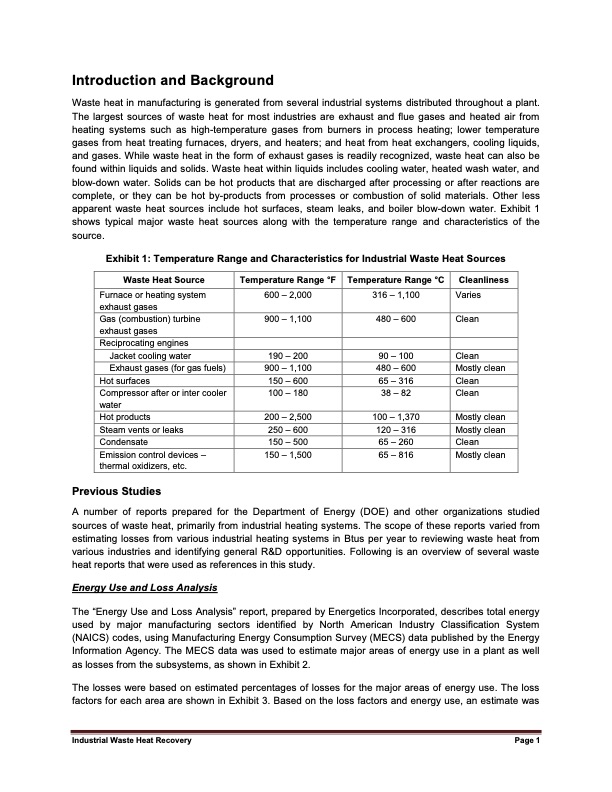
PDF Publication Title:
Text from PDF Page: 011
Introduction and Background Waste heat in manufacturing is generated from several industrial systems distributed throughout a plant. The largest sources of waste heat for most industries are exhaust and flue gases and heated air from heating systems such as high-temperature gases from burners in process heating; lower temperature gases from heat treating furnaces, dryers, and heaters; and heat from heat exchangers, cooling liquids, and gases. While waste heat in the form of exhaust gases is readily recognized, waste heat can also be found within liquids and solids. Waste heat within liquids includes cooling water, heated wash water, and blow-down water. Solids can be hot products that are discharged after processing or after reactions are complete, or they can be hot by-products from processes or combustion of solid materials. Other less apparent waste heat sources include hot surfaces, steam leaks, and boiler blow-down water. Exhibit 1 shows typical major waste heat sources along with the temperature range and characteristics of the source. Exhibit 1: Temperature Range and Characteristics for Industrial Waste Heat Sources Waste Heat Source Furnace or heating system exhaust gases Gas (combustion) turbine exhaust gases Reciprocating engines Jacket cooling water Exhaust gases (for gas fuels) Hot surfaces Compressor after or inter cooler water Hot products Steam vents or leaks Condensate Emission control devices – thermal oxidizers, etc. Previous Studies Temperature Range °F 600 – 2,000 900 – 1,100 190 – 200 900 – 1,100 150 – 600 100 – 180 200 – 2,500 250 – 600 150 – 500 150 – 1,500 Temperature Range °C 316 – 1,100 480 – 600 90 – 100 480 – 600 65 – 316 38 – 82 100 – 1,370 120 – 316 65 – 260 65 – 816 Cleanliness Varies Clean Clean Mostly clean Clean Clean Mostly clean Mostly clean Clean Mostly clean A number of reports prepared for the Department of Energy (DOE) and other organizations studied sources of waste heat, primarily from industrial heating systems. The scope of these reports varied from estimating losses from various industrial heating systems in Btus per year to reviewing waste heat from various industries and identifying general R&D opportunities. Following is an overview of several waste heat reports that were used as references in this study. Energy Use and Loss Analysis The “Energy Use and Loss Analysis” report, prepared by Energetics Incorporated, describes total energy used by major manufacturing sectors identified by North American Industry Classification System (NAICS) codes, using Manufacturing Energy Consumption Survey (MECS) data published by the Energy Information Agency. The MECS data was used to estimate major areas of energy use in a plant as well as losses from the subsystems, as shown in Exhibit 2. The losses were based on estimated percentages of losses for the major areas of energy use. The loss factors for each area are shown in Exhibit 3. Based on the loss factors and energy use, an estimate was Industrial Waste Heat Recovery Page 1PDF Image | Industrial Waste Heat Recovery: Potential

PDF Search Title:
Industrial Waste Heat Recovery: PotentialOriginal File Name Searched:
Pub52987.pdfDIY PDF Search: Google It | Yahoo | Bing
NFT (Non Fungible Token): Buy our tech, design, development or system NFT and become part of our tech NFT network... More Info
IT XR Project Redstone NFT Available for Sale: NFT for high tech turbine design with one part 3D printed counter-rotating energy turbine. Be part of the future with this NFT. Can be bought and sold but only one design NFT exists. Royalties go to the developer (Infinity) to keep enhancing design and applications... More Info
Infinity Turbine IT XR Project Redstone Design: NFT for sale... NFT for high tech turbine design with one part 3D printed counter-rotating energy turbine. Includes all rights to this turbine design, including license for Fluid Handling Block I and II for the turbine assembly and housing. The NFT includes the blueprints (cad/cam), revenue streams, and all future development of the IT XR Project Redstone... More Info
Infinity Turbine ROT Radial Outflow Turbine 24 Design and Worldwide Rights: NFT for sale... NFT for the ROT 24 energy turbine. Be part of the future with this NFT. This design can be bought and sold but only one design NFT exists. You may manufacture the unit, or get the revenues from its sale from Infinity Turbine. Royalties go to the developer (Infinity) to keep enhancing design and applications... More Info
Infinity Supercritical CO2 10 Liter Extractor Design and Worldwide Rights: The Infinity Supercritical 10L CO2 extractor is for botanical oil extraction, which is rich in terpenes and can produce shelf ready full spectrum oil. With over 5 years of development, this industry leader mature extractor machine has been sold since 2015 and is part of many profitable businesses. The process can also be used for electrowinning, e-waste recycling, and lithium battery recycling, gold mining electronic wastes, precious metals. CO2 can also be used in a reverse fuel cell with nafion to make a gas-to-liquids fuel, such as methanol, ethanol and butanol or ethylene. Supercritical CO2 has also been used for treating nafion to make it more effective catalyst. This NFT is for the purchase of worldwide rights which includes the design. More Info
NFT (Non Fungible Token): Buy our tech, design, development or system NFT and become part of our tech NFT network... More Info
Infinity Turbine Products: Special for this month, any plans are $10,000 for complete Cad/Cam blueprints. License is for one build. Try before you buy a production license. May pay by Bitcoin or other Crypto. Products Page... More Info
| CONTACT TEL: 608-238-6001 Email: greg@infinityturbine.com | RSS | AMP |